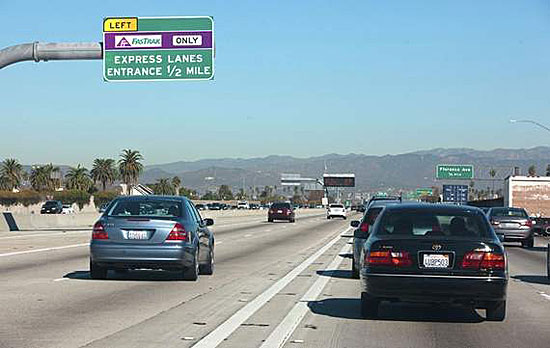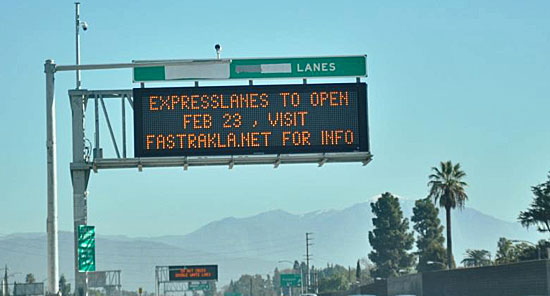Look who’s in the fast lane
February 7, 2013
As Los Angeles learns the ins and outs of its first toll roads, the agency behind the pilot project is taking a look at who the early adopters are.
And wondering why folks in Tenafly, New Jersey, Peoria, Illinois and Peterborough, New Hampshire saw fit to purchase one of the new transponders to drive on the 11-mile stretch of ExpressLanes on the 110 Freeway south of downtown L.A.
“Maybe they’re business travelers. Maybe they’re the parents of students going to school out here,” said Stephanie Wiggins, who manages the ExpressLanes project for Metro and says she expects to learn more about the out-of-town phenomenon as research continues.
As it stands now, people from more than 400 cities and towns in California and across the country as far away as Honolulu have purchased FasTrak transponders since the program started in November.
Most, however, are from Los Angeles County—where Metro’s ZIP code analysis shows that Los Angeles residents are the top transponder buyers, followed by people in Torrance, Redondo Beach and Long Beach. The Top 10 also includes residents of more northerly communities like Pasadena and Glendale.
Some 88,000 transponders were in circulation as of Tuesday, putting the project on a fast track toward reaching its goal of 100,000 in its first year of operation.
A second set of toll lanes, running for 14 miles on the 10 Freeway between Alameda Street in downtown Los Angeles and the 605 Freeway, is set to open on Feb. 23.
As Metro and Caltrans prepare to roll out the lanes on the 10, they’re analyzing what they’ve learned so far and how to apply it.
For example, outreach is being stepped up to include 230 religious institutions along the 110 corridor, where brochures will be distributed and “pulpit presentations” are planned, either by clergy or ExpressLanes representatives.
“Faith-based organizations are a powerful forum for getting information out to community members,” Wiggins said.
They’re also a good place to get out the word about the program’s “equity plan,” in which low-income households can get a transponder for $15—instead of the $40 usually required. Smaller discounts for transponders, which work on toll lanes throughout California, not just in L.A. County, are available when purchased through the Automobile Club of Southern California, Costco and Albertsons.
There have been no accidents attributed to the ExpressLanes, but officials are increasing signage to make sure motorists know the rules of the road. Wiggins said there have been reports of “near-misses” on the 110 involving drivers who have dangerously crossed the double white lines between the toll lanes and regular lanes, perhaps trying to avoid a fine for getting caught on camera without a transponder.
Another side effect of the toll lanes: traffic has gotten more congested in the freeway lanes next to them. Wiggins said that traffic should eventually revert to normal as motorists become familiar with the stretch and the influx of CHP officers now patrolling it.
On another front, Metro’s Board of Directors is considering whether to scrap the program’s $3 monthly maintenance fee, which is charged to occasional users who drive in the lanes fewer than four times a month. Supervisor and Metro Director Zev Yaroslavsky contends in a motion that the fee should be dropped as a matter of fairness.
The ExpressLanes replaced what was formerly a high-occupancy vehicle lane on the 110. But Metro’s analysis shows that carpoolers—who ride for free in the new lanes as long as they purchase a transponder—still represent 62% of the customers so far and have been using the lanes most heavily between 7 a.m. and 8 a.m.
Solo drivers, who pay tolls when they use the lanes, make up 38% of ExpressLanes users and are out in greatest force between 8 a.m. and 9 a.m.
Overall, the number of daily trips is increasing, from 39,820 in mid-November to 43,900 by mid-January.
For those overseeing the pilot project, though, the most important number is 45—as in miles per hour. That’s the minimum average speed the lanes must achieve to be considered a success, under the terms of the $210 million federal grant that’s paying for them.
So far, they’ve been up to speed 100% of the time.
Posted 2/7/13














 405 bridge work causes a stink
405 bridge work causes a stink

